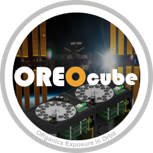OREOcube
|
|
|
|
The OREOcube project investigates the effects of solar and cosmic radiation on organic molecules of relevance for astrochemistry and astrobiology. OREOcube is designed to perform in-situ UV-Vis-NIR spectroscopy to study the photochemistry of organic thin films in contact with inorganic substrates, while being exposed to the space environment on the outside of the International Space Station (ISS). OREOcube is a cubesat based space exposure platform with in-situ UV-Vis-NIR spectroscopy capabilities, which allows to investigate the origin and evolution of organic molecules in space and planetary environments. It is part of a new “European Exposure Facility”, which is currently under development by the European Space Agency. In order to investigate the effects of unfiltered solar and cosmic radiation on specific organic compound. OREOcube leverages its heritage from the O/OREOS (Organism/Organic Exposure to Orbital Stresses) nanosatellite and its SEVO (Space Environment Viability of Organics) payload. In comparison to previous passive exposure platforms on the ISS, OREOcube will allow to monitor photochemical changes via in-situ UV-Vis-NIR spectroscopy while samples are being expose. OREOcube will collect daily, or even more frequently, sample spectra of selected organic compounds in order to monitor their photo-degradation profile over the duration of the up to 18 months long mission. A special focus is laid on the photochemical evolution and distribution of organic compounds relevant for the emergence and detection of life on Earth and other planets, such as Mars. By depositing organic samples as UV-transparent thin films onto inorganic substrates, structural changes and organic-inorganic interactions can be examined in order to understand the role that solid mineral surfaces (e.g. iron oxide, titanium oxides, iron and iron-nickel alloys and iron sulfide) play in the (photo)chemical alteration organics in the interstellar medium, comets, meteorites, and other bodies in space. An understanding of these processes is needed to characterise and model the chemistry of organic species associated with mineral surfaces in the astrochemical/astrobiological context. Candidate organic molecules for thin-film preparation include polycyclic aromatic hydrocarbons, quinones and porphyrins. Inorganic compounds of interest include silicates, metal oxides, iron-sulfide and iron-nickel alloys. By measuring changes in the UV-Vis-NIR spectra of samples as a function of time in situ, OREOcube will provide data sets that capture critical kinetic and mechanistic details of sample reactions that are not obtainable with the current passive exposure facilities on the ISS. Furthermore, combining in-situ measurements with post-flight sample analysis will provide time course studies as well as in-depth chemical analysis. |
|
